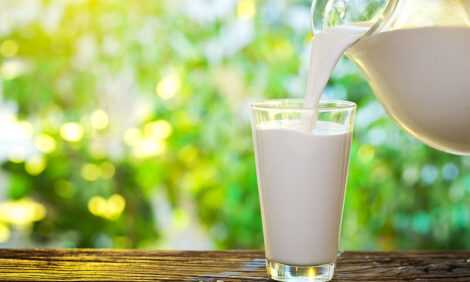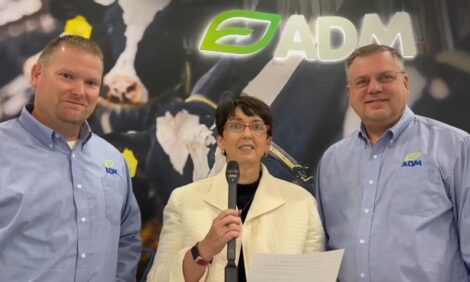



Impact of Dry Cow Cooling on Subsequent Performance and Health
There is compelling evidence that cooling dry cows improves milk yield in the next lactation, writes G.E. Dahl, University of Florida.Introduction
Heat stress has profound negative effects in lactating cows, and some of that response is due to
depressed dry matter intake (Collier et al., 2006). Recent evidence suggests that other physiological
insults related to the heat are responsible for the remaining negative effects on yield, which
indicates that alternate coping mechanisms are active in the cow that may affect other production
endpoints (Wheelock et al., 2010). Therefore it is perhaps not surprising that lactating cows are
adversely affected beyond simply reducing intake, as heat stress compromises reproductive
performance and various health outcomes in addition to the lower yields (Collier et al., 2006).
Dry cows typically consume much lower amounts of dry matter relative to lactating cows, and thus
are able to cope with heat stress more effectively than those producing milk. But despite the lower
DMI, heat stress of dry cows has significant negative impacts on yield in the subsequent lactation,
and those effects persist throughout lactation (Wolfenson et al., 1988). We have recently shown
that heat stressed dry cows also experience reduced immune function and are at higher risk for
disease compared with cows that are cooled when dry (do Amaral et al., 2010; 2011). This paper
describes the impact of heat stress during the dry period on various aspects of performance and
health as cows transition into lactation, and provides some considerations for management
interventions that are useful to overcome effects of heat stress.
Milk Yield and Mammary Growth
Early studies to address the effects of heat stress on dry cows focused on providing shade to animals
as a heat abatement strategy. Collier et al. (1982) observed that simply shading cows reduced body
temperatures relative to cows without shade, and lower rectal temperatures were associated with
heavier calf birth weights, longer gestation length, and suggested that milk yield would be improved
with that approach. The next step was the use of active cooling approaches, including fans and
soakers to more effectively reduce heat load versus shade alone, to improve the performance in the
next lactation. Wolfenson et al. (1988) showed that cooling dry cows increased the birth weights of
calves and improved milk yield 3.6 kg/d during the first 150 DIM. Thus, active cooling during the
dry period dramatically increases yield in the subsequent lactation. There is, however, a duration
effect, as other studies indicate that cows cooled for only the final portion of the dry period had a
lower milk response relative to studies that cool cows the entire dry period (Urdaz et al., 2006).
We have recently completed a series of studies that confirm the positive impact of heat stress
abatement in the dry period on performance in the next lactation (do Amaral et al., 2009; 2011; Tao
et al., 2011; 2012; Thompson et al., 2012). The approach we used was to provide shade to all cows
by housing them in a free stall barn for the entire dry period. The cooled cows had access to feedline
soakers and fans over the freestalls, whereas the heat stressed group had only shade. Figure 1 illustrates the typical milk yield response of cows that are cooled when dry (Tao et al., 2011). The
consistency of the milk yield response across 5 experiments is striking, with persistent increases in
yield of 3.5 kg/d for the entire lactation. It is clear that dry cows that are cooled produce more milk
in the next lactation, but the question becomes what is the underlying physiology that causes the
response?
In any situation, milk yield is a function of the number of mammary cells and the relative metabolic
activity of those cells. Although an increase in either cell number or activity can increase yield, an
increase in cell number would be expected to cause persistent increments whereas an effect on
metabolism may more transient. Using a serial mammary biopsy technique we collected mammary
samples from cows during the dry period and into early lactation; cows were cooled or heat stressed
when dry (Tao et al., 2011). Relative to heat stressed cows, we observed an increase in the
proliferation of mammary cells in cooled cows during the transition, which indicates greater
capacity for milk synthesis. Another factor that influences total mammary cell number is the rate of
loss of cells, or apoptosis. There was no difference in the rate of apoptosis between heat stressed
and cooled cows. Therefore, cooled cows have a greater net gain in secretory capacity during the
dry period, and that is expressed as higher milk yield in lactation.
Dry Matter Intake and Metabolism
As in lactating cows, dry cows under heat stress will reduce dry matter intake (Figure 2; Tao et al.,
2011; 2012). The reduction in intake is evident very soon after heat stress is applied, and remains
for as long as the cow is heat stressed. We observed that bodyweight and body condition score
increases follow cooling of dry cows, but cooled cows lose a greater share of bodyweight and
condition post-partum, likely as a function of the greater milk yields associated with prepartum
cooling (Tao et al., 2011; 2012).
In contrast to intake, there is no evidence that dry period heat stress alters the physiological control
of nutrient metabolism (Tao et al., 2012). For example, basal concentrations of insulin were not
different in heat stressed vs. cooled cows when they were dry, but differences did manifest during
lactation. Circulating NEFA concentrations were also not different in cooled and heat stressed cows
during the dry period. However, cows cooled when dry did lose more weight and body condition
post-partum relative to heat stressed cows once lactation began, though this was likely a result of
much greater milk yield.
Immune Status and Health
Our previous work with another environmental factor that affects performance and health of dry
cows, namely short day photoperiod, provides evidence that altered prolactin signaling drives many
of the observed effects on milk yield and immune status (Dahl et al., 2012). Specifically, decreases
in light exposure, i.e. short day photoperiod, reduces circulating prolactin concentrations relative to
a long day (Figure 3). However, prolactin receptor expression at various tissues including the
mammary gland and immune cells increases, thereby enhancing the responsiveness of those tissues.
Because cooling cows causes a similar reduction in prolactin to that shown for short days, we
hypothesized that cooling dry cows would increase immune function and improve health during the
transition (Dahl, 2008).
There are two primary arms to the immune system. Innate immunity is the non-specific response to
a pathogen or other non-self molecule, whereas acquired immunity is a specific antibody generated
response. We compared various aspects of both arms of the system in dry cows cooled or exposed
to heat stress. Cows that were actively cooled during the dry period had lower circulating prolactin
compared with heat stressed cows, and the lymphocyte expression of prolactin receptor was
increased (do Amaral et al., 2010). Those same cooled cows had greater lymphocyte proliferation
versus the heat stressed animals, an indication of improved immune status. Cooling also increased
the capacity for neutrophils to destroy bacteria through the process of oxidative burst generation (do
Amaral et al., 2011). Thus, cooling dry cows improved the ability to resist infection in early
lactation.
With regard to acquired immune function, we examined the cow’s ability to generate antibodies to a
specific non-self protein, i.e. ovalbumin (do Amaral et al., 2011). Cows were injected with
ovalbumin early in the dry period and then received boosters of ovalbumin through the dry period
and into lactation. Of interest, cooled cows had greater ovalbumin IgG responses relative to heat
stressed cows, but that effect was evident only during the dry period (Figure 4). So it appears that
the two arms of the immune system act differently in response to environmental factors. That is, the
acquired immune function appears to be influenced during the dry period, whereas the innate
system is affected during the initial stages of the next lactation. In both cases, however,
improvements in immune status would result from cooling of dry cows.
Conclusions
Based on previous studies and our recent work, there is compelling evidence that cooling dry cows improves milk yield in the next lactation. In addition, those cows that are cooled are better able to navigate the metabolic challenges of early lactation, and have improved immune status at a time of significant risk for disease. The approach to cooling is the same as that for lactating cows but should be implemented as early in the dry period as possible to maximize the benefits to the cow as she transitions into lactation.
References
- Collier, R.J., S.G. Doelger, H.H. Head, W.W. Thatcher, and C.J. Wilcox. 1982. Effects of heat stress during pregnancy on maternal hormone concentrations, calf birth weight and postpartum milk yield of Holstein cows. J. Anim Sci. 54:309-319.
- Collier, R.J., G.E. Dahl, and M.J. Van Baale. 2006. Major advances associated with environmental effects on dairy cattle. J. Dairy Sci. 89:1244-1253.
- Dahl, G.E., S. Tao, and I.M. Thompson. 2012. Effects of photoperiod on mammary gland development and lactation. J. Anim. Sci. 90:755-760.
- Dahl, G.E. 2008. Effects of short day photoperiod on prolactin signaling of dry cows: A common mechanism among tissues and environments? J. Anim. Sci. 86:10-14.
- do Amaral B.C., E.E. Connor, S. Tao, J. Hayen, J. Bubolz, and G.E. Dahl. 2009. Heat stress abatement during the dry period: does cooling improve transition into lactation? J. Dairy Sci. 92:5988-5999.
- do Amaral B.C., E.E. Connor, S. Tao, J. Hayen, J. Bubolz, and G.E. Dahl. 2010. Heat stress abatement during the dry period influences prolactin signaling in lymphocytes. Domest. Anim. Endo. 38:38-45.
- do Amaral B.C., E.E. Connor, S. Tao, J. Hayen, J. Bubolz, and G.E. Dahl. 2011. Heat stress abatement during the dry period influences hepatic gene expression and improves immune status during the transition period of dairy cows. J. Dairy Sci. 94:86-96.
- Tao, S., J.W. Bubolz, B.C. do Amaral, I.M. Thompson, M.J. Hayen, S.E. Johnson and G.E. Dahl. 2011. Effect of heat stress during the dry period on mammary gland development. J. Dairy Sci. 94:5976-5986.
- Tao, S., I.M. Thompson, A.P.A. Monteiro, M.J. Hayen, L.J. Young and G.E. Dahl. 2012. Effect of cooling heat stressed during the dry period on insulin response. J. Dairy Sci. 95: Revision submitted.
- Thompson, I.M., S. Tao, A.P. Monteiro, K.C. Jeong, W.W. Thatcher, and G.E. Dahl. 2012. Effect of cooling during the dry period on neutrophil gene expression after Streptococcus uberis infection. J. Dairy Sci. 95(Suppl. 1). Abstract #50652.
- Urdaz J.H., M.W. Overton, D.A. Moore, and J.E. Santos. 2006. Technical note: Effects of adding shade and fans to a feedbunk sprinkler system for preparturient cows on health and performance. J. Dairy Sci. 89:2000-2006.
- Wheelock, J.B., R.P. Rhoads, M.J. Vanbaale, S.R. Sanders, and L.H. Baumgard. 2010. Effects of heat stress on energetic metabolism in lactating Holstein cows. J. Dairy Sci. 93:644-655.
- Wolfenson, D., I. Flamenbaum, and A. Berman. 1988. Dry period heat stress relief effects on prepartum progesterone, calf birth weight, and milk production. J. Dairy Sci. 71:809-818.
July 2012


